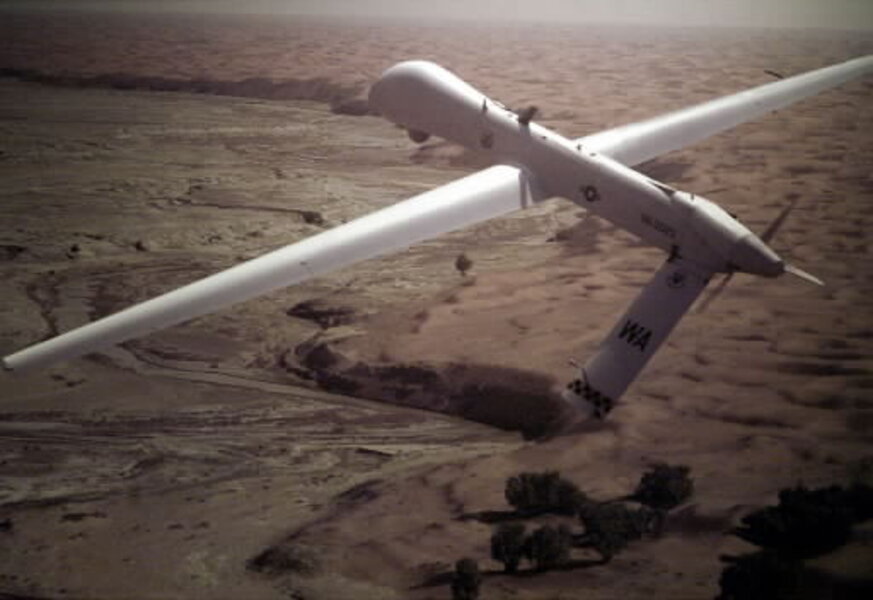Drone aircraft in a stepped-up war in Afghanistan and Pakistan
Loading...
| Washington
It will take some time for 30,000 more US troops to deploy to Afghanistan, as called for by President Obama’s new Afghan strategy. Already in operation, however, may be another part of the plan: an increase in covert strikes against militant targets by missiles fired from unmanned Predator drones.
Evidence of this surfaced Tuesday, with reports that the US launched a drone attack in northwest Pakistan that may have killed a key member of Al Qaeda.
“Nothing has been definitively confirmed, but it’s possible that a senior Al Qaeda figure has died,” a US official told the Reuters news service.
The US government has not officially talked about the strike, nor is it likely to. The drone program is a covert effort run by the CIA. Neither Osama bin Laden nor Ayman al-Zawahiri was the likely target, however, according to wire service reports.
The Predator can loiter over a target for hours
The RQ-1 Predator drone is the primary unmanned aerial vehicle used for offensive operations in Afghanistan and the adjoining Pakistani tribal areas. Its endurance is such that it can fly 400 nautical miles to a target, loiter overhead for 14 hours, then return.
US generals testifying before Congress in recent weeks about the new Afghanistan strategy declined to discuss the issue of missile strikes in public. Again, the program is supposed to be classified. But they freely discussed their appreciation for the intelligence and reconnaissance-gathering abilities of UAVs, which are the flip side of the technology’s abilities.
“These programs are expensive, but they are extraordinarily effective and extraordinarily value-added,” Gen. Stanley McChrystal, commander of US forces in Afghanistan, told the Senate Armed Services Committee on Dec. 8.
According to a recent think-tank report, armed drone strikes have dramatically increased under Mr. Obama – even before his recent decision to bulk up US forces there.
There were 43 such attacks between January and October 2009, according to a New America Foundation report. The report draws on what it deems to be credible local and national media stories about the attacks. That compares with a total of 34 in all of 2008, President Bush’s last full year in office.
Debate over civilian casualties
Since 2006, drone-launched missiles have killed between 750 and 1,000 people in Pakistan, according to the New American report. Of these, about 20 people were leaders of Al Qaeda, Taliban, and associated groups. Overall, about 66 to 68 percent of the people killed were militants, and between 31 and 33 percent were civilians, according to the report.
"It is not possible to differentiate precisely between militant and civilian casualties because the militants live among the population and don’t wear uniforms,” write Peter Bergen and Katherine Tiedemann, New America Foundation research fellows, in the study. US officials dispute the assertion that up to 30 percent of those killed by the unmanned aerial vehicle attacks are civilians.
At a recent appearance at the American Veterans Center’s annual conference, Gen. David Petraeus, commander of US Central Command, said he did not believe civilian casualties in the region have increased.
“With respect to Afghanistan, the loss of innocent civilian life has been dramatically reduced,” said General Petraeus, in response to a question about the utility of the Predator attacks.
Winning over the "human terrain"
The main goal of a counterinsurgency operation is to win over the human terrain – the local population, said Petraeus. The US recognizes that would not be possible if large numbers of civilians are killed in errant missile strikes. At the same time, the US wants to make use of its best weapons, said Petraeus.
“So all of that … argues against the idea that you would deny yourself those very effective platforms, particularly when it comes to the most senior leaders of organizations that are trying to carry out attacks in our homeland,” said the Central Command chief.





